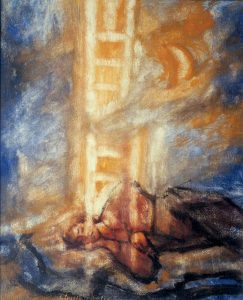How high will you climb?
Before Augustine became a priest, bishop, Church Doctor, and saint he was a pagan, heretic, thief, and according to his own confessions, a profligate scoundrel. At seventeen he fathered a son Adeodatus out of wedlock by a woman with whom he had a long-standing relationship.

Jacob’s Ladder
Augustine’s conversion occurred in August 386 and he was baptized at Easter 387 at the age of 33. Prior to his conversion he was a professor of rhetoric, initially at Carthage and later at Rome. He had a keen intellect, was well educated, and had a long, passionate search for the truth along with an equally passionate need for sexual relationships. Those who are want to know more of him are often surprised that for nine years he followed Manicheanism, which as one translator tells it was a farrago of nonsense.[1]
Unlike many of the earliest members of Christ’s church, we don’t have to rely on sparse historical records to discover Augustine for all that is necessary is to read his confessions, considered to be his greatest work. He began writing The Confessions in 397 at the age of 43, ten years after his baptism, after having been a priest for six years and a bishop for two.
What we ought to make of Augustine is this: for many of us today, not much has changed in over 1600 years, for we still find the world filled with pagans, thieves, and far too many profligate scoundrels. But we also have our share of saints and holy people of God.
Over the past few weeks I have written more than a few words concerning the large number of ‘Cafeteria Catholics’ who are want to mosey up to the à la carte buffet when it comes to their faith. While I have, as previously acknowledged, received some amount of criticism for what I wrote I stand firmly convicted and cannot nor will not alter what I have so written. At the risk of further offending those who would continue to gorge themselves at the cafeteria buffet I would recommend two quick reads: First read The Confessions of Saint Augustine and then pick up and read Jacob’s Ladder: Ten Steps to Truth[2] by renown and respected theologian, philosopher, and Catholic apologist Peter Kreeft.
Jacob’s Ladder is written as a series of ten dialogues between two fictional but marvelously interesting women as they climb ten rungs of a ladder leading to conversion and faith. The last rung is Authority and much of the dialogue centers around the Catholic Church’s teachings on sex. Here is an important part of that dialogue:
“You see, the sexual revolution trumps everything, even your responsibility to your spouse and your responsibility to your children and your responsibility to your society. And it’s so strong that even among Catholics Humanae Vitae is the most hated and rejected and disobeyed encyclical in history. It’s a touchstone. All ‘cafeteria Catholics’ reject it; all faithful Catholics accept it…”
“Then how can there be so many ‘cafeteria Catholics’?”
“There’s no such thing, really. It’s a contradiction in terms. Catholic means ‘universal’, or ‘whole’, or ‘all’. Cafeteria means only ‘some’. It means being picky and choosy. You know what the Greek word for ‘pick and choose’ is?”
“No. What?”
“Heretic.”
“Oops.”
Perhaps a better response might be “OUCH!”
Still unconvinced? It comes from the Greek: hairetikos ‘able to choose’; also haireisthai ‘choose’. Look it up if you are still in doubt.
[1] St. Augustine, Sr. Maria Boulding, The Confessions, New City Press, Apr 1, 2007.
[2] Peter Kreeft, Jacob’s Ladder: Ten Steps to Truth, Ignatius Press, Mar 21, 2013. Peter Kreeft is professor of philosophy at Boston College and the author of 75 books as well as numerous papers..
